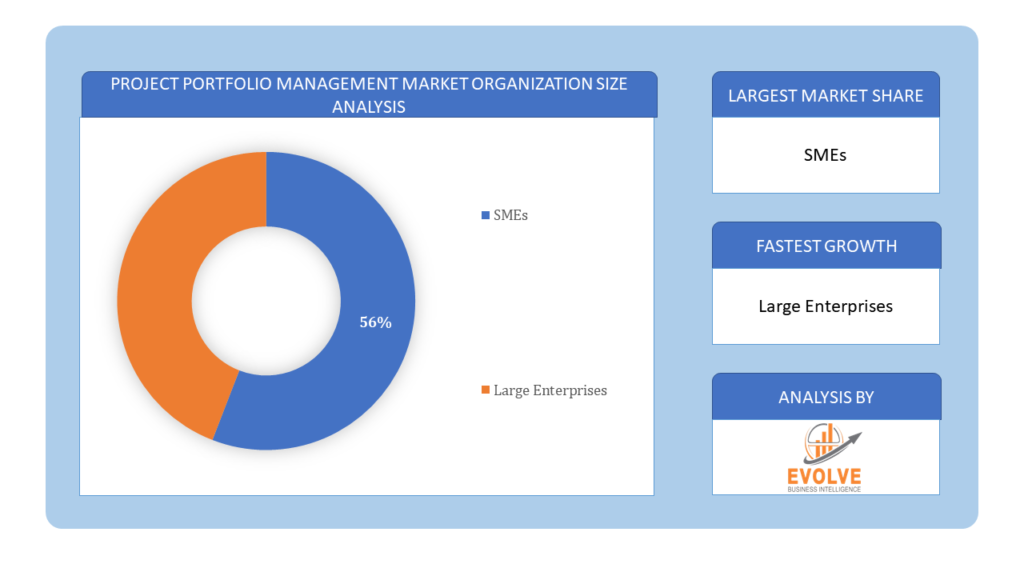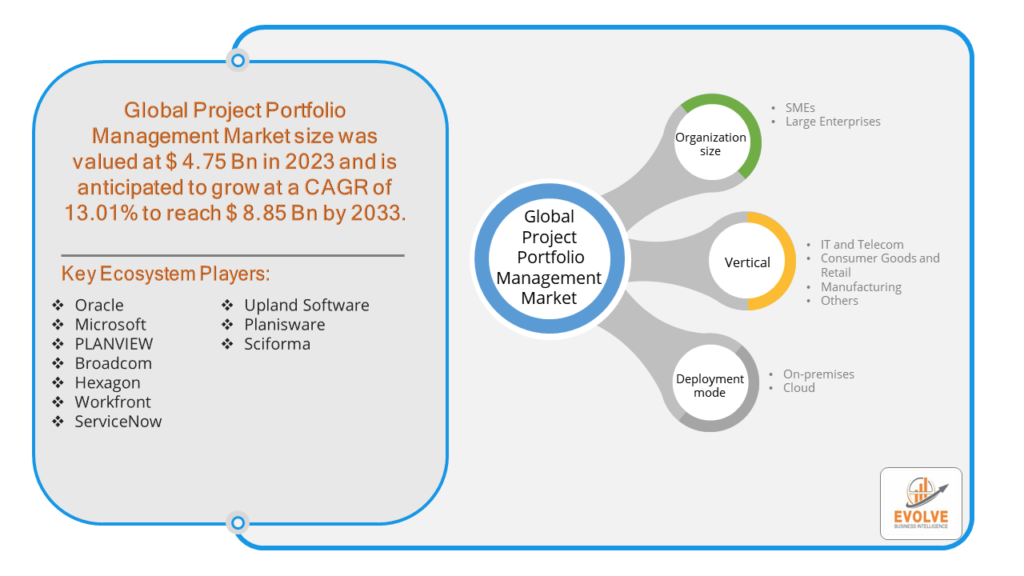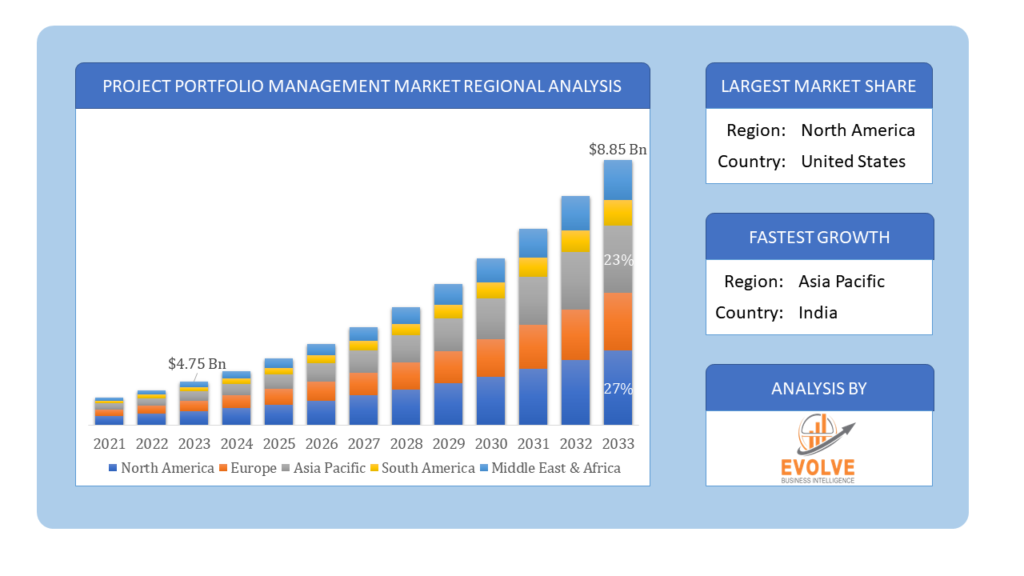Project Portfolio Management Market Analysis and Global Forecast 2023-2033
$ 1,390.00 – $ 5,520.00Price range: $ 1,390.00 through $ 5,520.00
Project Portfolio Management Market Research Report: By organization size (SMEs, Large Enterprises), By vertical (IT and Telecom, Consumer Goods and Retail, Manufacturing, Others) By deployment mode (On-premises, Cloud), and by Region — Forecast till 2033
Page: 165
Project Portfolio Management Market Overview
The Project Portfolio Management Market Size is expected to reach USD 8.85 Billion by 2033. The Project Portfolio Management industry size accounted for USD 4.75 Billion in 2023 and is expected to expand at a compound annual growth rate (CAGR) of 13.01% from 2023 to 2033. Project Portfolio Management (PPM) is a strategic approach that enables organizations to manage multiple projects in a coordinated manner. PPM involves selecting, prioritizing, and controlling an organization’s projects to align them with its strategic goals and objectives. It provides a centralized view of all projects, facilitating resource allocation, risk management, and performance monitoring. By optimizing project portfolios, organizations can improve decision-making, enhance efficiency, and maximize returns on investment. PPM tools and techniques help ensure that projects are executed effectively and deliver the intended business value.
Global Project Portfolio Management Market Synopsis
The COVID-19 pandemic has led to supply chain disruptions leading to supply shortages or lower demand in the Project Portfolio Management market. The travel restrictions and social-distancing measures have resulted in a sharp drop in consumer and business spending and this pattern is to continue for some time. The end-user trend and preferences have changed due to the pandemic and have resulted in manufacturers, developers, and service providers to adopt various strategies to stabilize the company.
Global Project Portfolio Management Market Dynamics
The major factors that have impacted the growth of Project Portfolio Management are as follows:
Drivers:
⮚ Technological Advancements
The evolution of digital technologies, such as AI, machine learning, and cloud computing, has significantly enhanced PPM capabilities. Advanced PPM tools can now offer predictive analytics, real-time data insights, and automated reporting, making it easier to manage and optimize project portfolios.
Restraint:
- Data Security and Privacy Concerns
As PPM tools often involve the centralization of sensitive project and organizational data, there are significant concerns regarding data security and privacy. Organizations must ensure robust cybersecurity measures are in place to protect against data breaches and comply with data protection regulations, which can add to the complexity and cost of PPM implementation.
Opportunity:
⮚ Integration with Emerging Technologies
The integration of PPM tools with emerging technologies like artificial intelligence (AI), machine learning (ML), and blockchain offers significant potential. AI and ML can enhance predictive analytics, automate routine tasks, and provide deeper insights into project performance, while blockchain can improve transparency and security in project transactions and data sharing.
Project Portfolio Management Market Segment Overview
By Organization size
Based on the Organization size, the market is segmented based on SMEs, Large Enterprises. Based on the Organization size, the market is segmented based on SMEs, Large Enterprises.
By Vertical
 Based on the Vertical, the market has been divided into IT and Telecom, Consumer Goods and Retail, Manufacturing, Others. Based on the Vertical, the market has been divided into IT and Telecom, Consumer Goods and Retail, Manufacturing, Others.
Based on the Vertical, the market has been divided into IT and Telecom, Consumer Goods and Retail, Manufacturing, Others. Based on the Vertical, the market has been divided into IT and Telecom, Consumer Goods and Retail, Manufacturing, Others.
By Deployment mode
Based on Deployment mode, the market has been divided into On-premises, Cloud. the Project Portfolio Management (PPM) market is dominated by cloud-based solutions, driven by their scalability, flexibility, cost-effectiveness, and the increasing trend towards remote and hybrid work environments.
Global Project Portfolio Management Market Regional Analysis
Based on region, the market has been divided into North America, Europe, Asia-Pacific, the Middle East & Africa, and Latin America. The area of North America is anticipated to dominate the market for the usage of Generative AI, followed by those in Asia-Pacific and Europe.
 Project Portfolio Management North America Market
Project Portfolio Management North America Market
North America dominates the Project Portfolio Management market due to several factors. In terms of market share for project portfolio management software, North America leads the way. A few of the reasons behind the market’s expansion are the growing use of these tools across a range of industries, such as manufacturing and healthcare, and the significant investments made by multinational corporations in a number of well-known projects. Furthermore, because there are numerous suppliers in North America that provide businesses with all-inclusive solutions, the market as a whole is driven in that direction.
Project Portfolio Management Europe Market
The Europe region has been witnessing remarkable growth in recent years. Europe is the market’s second-place competitor. Europe is divided into the United Kingdom, France, Germany, Spain, Italy, and the remainder of Europe. The UK is predicted to increase its market share the most, followed by Germany and France, based on the MRFR analysis. The primary driver of the market’s expansion in the area is the increasing demand for efficient project management solutions.
Competitive Landscape
The competitive landscape includes key players (tier 1, tier 2, and local) having a presence across the globe. Companies such as Oracle, Microsoft, PLANVIEW, Broadcom, and Hexagon are some of the leading players in the global Project Portfolio Management Industry. These players have adopted partnership, acquisition, expansion, and new product development, among others as their key strategies.
Key Market Players:
- Oracle
- Microsoft
- PLANVIEW
- Broadcom
- Hexagon
- Workfront
- ServiceNow
- Upland Software
- Planisware
- Sciforma
Key development:
In November 2016, Planview announced the launch of Projectplace, a next-generation collaborative work management solution for teams
Scope of the Report
Global Project Portfolio Management Market, by Organization size
- SMEs
- Large Enterprises
Global Project Portfolio Management Market, by Vertical
- IT and Telecom
- Consumer Goods and Retail
- Manufacturing
- Others
Global Project Portfolio Management Market, by Deployment mode
- On-premises
- Cloud
Global Project Portfolio Management Market, by Region
- North America
- US
- Canada
- Mexico
- Europe
- UK
- Germany
- France
- Italy
- Spain
- Benelux
- Nordic
- Rest of Europe
- Asia Pacific
- China
- Japan
- South Korea
- Indonesia
- Austalia
- Malaysia
- India
- Rest of Asia Pacific
- South America
- Brazil
- Argentina
- Rest of South America
- Middle East & Africa
- Saudi Arabia
- UAE
- Egypt
- South Africa
- Rest of Middle East & Africa
| Parameters | Indicators |
|---|---|
| Market Size | 2033: $8.85 Billion |
| CAGR | 13.01% CAGR (2023-2033) |
| Base year | 2022 |
| Forecast Period | 2023-2033 |
| Historical Data | 2021 |
| Report Coverage | Revenue Forecast, Competitive Landscape, Growth Factors, and Trends |
| Key Segmentations | Organization size, Vertical, Deployment mode |
| Geographies Covered | North America, Europe, Asia-Pacific, Latin America, Middle East, Africa |
| Key Vendors | Oracle, Microsoft, PLANVIEW, Broadcom, Hexagon, Workfront, ServiceNow, Upland Software, Planisware, Sciforma |
| Key Market Opportunities | The presence of a number of vendors in North America, offering comprehensive solutions to the enterprises, thereby driving the overall market in the region |
| Key Market Drivers | • A large number of verticals are deploying such solutions across the globe, which is driving the market. |
REPORT CONTENT BRIEF:
- High-level analysis of the current and future Project Portfolio Management Industry trends and opportunities
- Detailed analysis of current market drivers, restraining factors, and opportunities analysis in the future
- Historical market size for the year 2021, and forecast from 2023 to 2033
- Project Portfolio Management market share analysis for each segment
- Competitor analysis with a comprehensive insight into its product segment, financial strength, and strategies adopted.
- Identifies key strategies adopted by the key players including new product development, mergers and acquisitions, joint ventures, collaborations, and partnerships.
- To identify and understand the various factors involved in the global Project Portfolio Management market affected by the pandemic
- To provide year-on-year growth from 2022 to 2033
- To provide short-term, long-term, and overall CAGR comparison from 2022 to 2033.
- Provide Total Addressable Market (TAM) for the Global Project Portfolio Management Market.
Frequently Asked Questions (FAQ)
1.What is the study period of this market?
- The study period of the global Project Portfolio Management market is 2022- 2033
2.What are the 10 Years CAGR (2023 to 2033) of the global Project Portfolio Management market?
- The global Project Portfolio Management market is growing at a CAGR of ~01% over the next 10 years
3.Which region has the highest growth rate in the market of Project Portfolio Management market?
- Asia Pacific is expected to register the highest CAGR during 2023-2033
4.Which region accounted for the largest share of the market of Project Portfolio Management market?
- North America holds the largest share in 2022
5.Major Key Players in the Market of Project Portfolio Management market?
- Oracle, Microsoft, PLANVIEW, Broadcom, Hexagon, Workfront, ServiceNow, Upland Software, Planisware, Sciforma
6.Do you offer Post Sale Support?
- Yes, we offer 16 hours of analyst support to solve the queries
7.Do you deliver sections of a report?
Yes, we do provide regional as well as country-level reports. Other than this we also provide a sectional report. Please get in contact with our sales representatives
Press Release

Global Pharmaceutical Manufacturing Market to Reach $1.38 Trillion by 2035 with 7.35% CAGR, New Research Shows

The Global Mammography Market Is Estimated To Record a CAGR of Around 10.29% During The Forecast Period

Glue Stick Market to Reach USD 2.35 Billion by 2034

Podiatry Service Market to Reach USD 11.88 Billion by 2034

Microfluidics Technology Market to Reach USD 32.58 Billion by 2034

Ferric Chloride Market to Reach USD 10.65 Billion by 2034

Family Practice EMR Software Market to Reach USD 21.52 Billion by 2034

Electric Hairbrush Market to Reach USD 15.95 Billion by 2034

Daily Bamboo Products Market to Reach USD 143.52 Billion by 2034

Cross-border E-commerce Logistics Market to Reach USD 112.65 Billion by 2034
Table of Content
CHAPTER 1. Executive Summary CHAPTER 2. Scope of the Study 2.1. Market Definition 2.2. Market Scope & Segmentation 2.2.1. Objective of Report CHAPTER 3. Evolve BI Methodology 3.1. Data Collection & Validation Approach 3.2. Market Size Estimation and Forecast CHAPTER 4. Exclusive Analysis 4.1. Market Opportunity Score 4.1.1. Technology Segement – Market Opportunity Score 4.1.2. End user Segment – Market Opportunity Score 4.1.3. Frequency Band Segment – Market Opportunity Score 4.2. Key Market Influencing Indicators CHAPTER 5. Market Insights and Trends 5.1. Value Chain Analysis 5.1.1. Raw Material 5.1.2. Manufacturing Process 5.1.3. Distribution Channel 5.1.4. End User 5.2. Porter’s Five Forces Analysis 5.2.1. Bargaining Power of Buyers 5.2.2. Bargaining Power of Suppliers 5.2.3. Threat of New Entrant 5.2.4. Threat of Substitute 5.2.5. Industry Rivalry 5.3. COVID-19 Impact and Post COVID Scenario on Private LTE Market 5.3.1. Impact of COVID-19 5.3.2. Government Support and Industry Revival Policies 5.3.3. Measures Taken by Companies to Mitigate Negative Impact 5.3.4. Post COVID Trend CHAPTER 6. MArket Dynamics 6.1. Introduction 6.2. Drivers 6.2.1. Driver 1 6.2.2. Driver 2 6.2.3. Driver 3 6.3. Restraints 6.3.1. Restraint 1 6.3.2. Restraint 2 6.4. Opportunity 6.4.1. Opportunity 1 CHAPTER 7. Global Private LTE Market, By Technology 7.1. Introduction 7.1.1. FDD 7.1.2. TDD CHAPTER 8. Global Private LTE Market, By End user 8.1. Introduction 8.1.1. Utilities 8.1.2. Mining 8.1.3. Manufacturing 8.1.4. Healthcare 8.1.5. Others CHAPTER 9. Global Private LTE Market, By Frequency Band 9.1. Introduction 9.1.1. Licensed 9.1.2. Unlicensed 9.1.3. Shared spectrum CHAPTER 10. Global Private LTE Market, By Region 10.1. Introduction 10.2. NORTH AMERICA 10.2.1. North America: Market Size and Forecast, By Country, 2023 – 2033 ($ Million) 10.2.2. North America: Market Size and Forecast, By Technology, 2023 – 2033 ($ Million) 10.2.3. North America: Market Size and Forecast, By End user, 2023 – 2033 ($ Million) 10.2.4. North America: Market Size and Forecast, By Frequency Band, 2023 – 2033 ($ Million) 10.2.5. US 10.2.5.1. US: Market Size and Forecast, By Technology, 2023 – 2033 ($ Million) 10.2.5.2. US: Market Size and Forecast, By End user, 2023 – 2033 ($ Million) 10.2.5.3. US: Market Size and Forecast, By Frequency Band, 2023 – 2033 ($ Million) 10.2.6. CANADA 10.2.6.1. Canada: Market Size and Forecast, By Technology, 2023 – 2033 ($ Million) 10.2.6.2. Canada: Market Size and Forecast, By End user, 2023 – 2033 ($ Million) 10.2.6.3. Canada: Market Size and Forecast, By Frequency Band, 2023 – 2033 ($ Million) 10.2.7. MEXICO 10.2.7.1. Mexico: Market Size and Forecast, By Technology, 2023 – 2033 ($ Million) 10.2.7.2. Mexico: Market Size and Forecast, By End user, 2023 – 2033 ($ Million) 10.2.7.3. Mexico: Market Size and Forecast, By Frequency Band, 2023 – 2033 ($ Million) 10.3. Europe 10.3.1. Europe: Market Size and Forecast, By Country, 2023 – 2033 ($ Million) 10.3.2. Europe: Market Size and Forecast, By Technology, 2023 – 2033 ($ Million) 10.3.3. Europe: Market Size and Forecast, By End user, 2023 – 2033 ($ Million) 10.3.4. Europe: Market Size and Forecast, By Frequency Band, 2023 – 2033 ($ Million) 10.3.5. U.K. 10.3.5.1. U.K.: Market Size and Forecast, By Technology, 2023 – 2033 ($ Million) 10.3.5.2. U.K.: Market Size and Forecast, By End user, 2023 – 2033 ($ Million) 10.3.5.3. U.K.: Market Size and Forecast, By Frequency Band, 2023 – 2033 ($ Million) 10.3.6. GERMANY 10.3.6.1. Germany: Market Size and Forecast, By Technology, 2023 – 2033 ($ Million) 10.3.6.2. Germany: Market Size and Forecast, By End user, 2023 – 2033 ($ Million) 10.3.6.3. Germany: Market Size and Forecast, By Frequency Band, 2023 – 2033 ($ Million) 10.3.7. FRANCE 10.3.7.1. France: Market Size and Forecast, By Technology, 2023 – 2033 ($ Million) 10.3.7.2. France: Market Size and Forecast, By End user, 2023 – 2033 ($ Million) 10.3.7.3. France: Market Size and Forecast, By Frequency Band, 2023 – 2033 ($ Million) 10.3.8. ITALY 10.3.8.1. Italy: Market Size and Forecast, By Technology, 2023 – 2033 ($ Million) 10.3.8.2. Italy: Market Size and Forecast, By End user, 2023 – 2033 ($ Million) 10.3.8.3. Italy: Market Size and Forecast, By Frequency Band, 2023 – 2033 ($ Million) 10.3.9. SPAIN 10.3.9.1. Spain: Market Size and Forecast, By Technology, 2023 – 2033 ($ Million) 10.3.9.2. Spain: Market Size and Forecast, By End user, 2023 – 2033 ($ Million) 10.3.9.3. Spain: Market Size and Forecast, By Frequency Band, 2023 – 2033 ($ Million) 10.3.10. BENELUX 10.3.10.1. BeNeLux: Market Size and Forecast, By Technology, 2023 – 2033 ($ Million) 10.3.10.2. BeNeLux: Market Size and Forecast, By End user, 2023 – 2033 ($ Million) 10.3.10.3. BeNeLux: Market Size and Forecast, By Frequency Band, 2023 – 2033 ($ Million) 10.3.11. RUSSIA 10.3.11.1. Russia: Market Size and Forecast, By Technology, 2023 – 2033 ($ Million) 10.3.11.2. Russia: Market Size and Forecast, By End user, 2023 – 2033 ($ Million) 10.3.11.3. Russia: Market Size and Forecast, By Frequency Band, 2023 – 2033 ($ Million) 10.3.12. REST OF EUROPE 10.3.12.1. Rest of Europe: Market Size and Forecast, By Technology, 2023 – 2033 ($ Million) 10.3.12.2. Rest of Europe: Market Size and Forecast, By End user, 2023 – 2033 ($ Million) 10.3.12.3. Rest of Europe: Market Size and Forecast, By Frequency Band, 2023 – 2033 ($ Million) 10.4. Asia Pacific 10.4.1. Asia Pacific: Market Size and Forecast, By Country, 2023 – 2033 ($ Million) 10.4.2. Asia Pacific: Market Size and Forecast, By Technology, 2023 – 2033 ($ Million) 10.4.3. Asia Pacific: Market Size and Forecast, By End user, 2023 – 2033 ($ Million) 10.4.4. Asia Pacific: Market Size and Forecast, By Frequency Band, 2023 – 2033 ($ Million) 10.4.5. CHINA 10.4.5.1. China: Market Size and Forecast, By Technology, 2023 – 2033 ($ Million) 10.4.5.2. China: Market Size and Forecast, By End user, 2023 – 2033 ($ Million) 10.4.5.3. China: Market Size and Forecast, By Frequency Band, 2023 – 2033 ($ Million) 10.4.6. JAPAN 10.4.6.1. Japan: Market Size and Forecast, By Technology, 2023 – 2033 ($ Million) 10.4.6.2. Japan: Market Size and Forecast, By End user, 2023 – 2033 ($ Million) 10.4.6.3. Japan: Market Size and Forecast, By Frequency Band, 2023 – 2033 ($ Million) 10.4.7. INDIA 10.4.7.1. India: Market Size and Forecast, By Technology, 2023 – 2033 ($ Million) 10.4.7.2. India: Market Size and Forecast, By End user, 2023 – 2033 ($ Million) 10.4.7.3. India: Market Size and Forecast, By Frequency Band, 2023 – 2033 ($ Million) 10.4.8. SOUTH KOREA 10.4.8.1. South Korea: Market Size and Forecast, By Technology, 2023 – 2033 ($ Million) 10.4.8.2. South Korea: Market Size and Forecast, By End user, 2023 – 2033 ($ Million) 10.4.8.3. South Korea: Market Size and Forecast, By Frequency Band, 2023 – 2033 ($ Million) 10.4.9. THAILAND 10.4.9.1. Thailand: Market Size and Forecast, By Technology, 2023 – 2033 ($ Million) 10.4.9.2. Thailand: Market Size and Forecast, By End user, 2023 – 2033 ($ Million) 10.4.9.3. Thailand: Market Size and Forecast, By Frequency Band, 2023 – 2033 ($ Million) 10.4.10. INDONESIA 10.4.10.1. Indonesia: Market Size and Forecast, By Technology, 2023 – 2033 ($ Million) 10.4.10.2. Indonesia: Market Size and Forecast, By End user, 2023 – 2033 ($ Million) 10.4.10.3. Indonesia: Market Size and Forecast, By Frequency Band, 2023 – 2033 ($ Million) 10.4.11. MALAYSIA 10.4.11.1. Malaysia: Market Size and Forecast, By Technology, 2023 – 2033 ($ Million) 10.4.11.2. Malaysia: Market Size and Forecast, By End user, 2023 – 2033 ($ Million) 10.4.11.3. Malaysia: Market Size and Forecast, By Frequency Band, 2023 – 2033 ($ Million) 10.4.12. AUSTRALIA 10.4.12.1. Australia: Market Size and Forecast, By Technology, 2023 – 2033 ($ Million) 10.4.12.2. Australia: Market Size and Forecast, By End user, 2023 – 2033 ($ Million) 10.4.12.3. Australia: Market Size and Forecast, By Frequency Band, 2023 – 2033 ($ Million) 10.4.13. REST FO ASIA PACIFIC 10.4.13.1. Rest fo Asia Pacific: Market Size and Forecast, By Technology, 2023 – 2033 ($ Million) 10.4.13.2. Rest fo Asia Pacific: Market Size and Forecast, By End user, 2023 – 2033 ($ Million) 10.4.13.3. Rest fo Asia Pacific: Market Size and Forecast, By Frequency Band, 2023 – 2033 ($ Million) 10.5. South America 10.5.1. South America: Market Size and Forecast, By Country, 2023 – 2033 ($ Million) 10.5.2. South America: Market Size and Forecast, By Technology, 2023 – 2033 ($ Million) 10.5.3. South America: Market Size and Forecast, By End user, 2023 – 2033 ($ Million) 10.5.4. South America: Market Size and Forecast, By Frequency Band, 2023 – 2033 ($ Million) 10.5.5. BRAZIL 10.5.5.1. Brazil: Market Size and Forecast, By Technology, 2023 – 2033 ($ Million) 10.5.5.2. Brazil: Market Size and Forecast, By End user, 2023 – 2033 ($ Million) 10.5.5.3. Brazil: Market Size and Forecast, By Frequency Band, 2023 – 2033 ($ Million) 10.5.6. ARGENTINA 10.5.6.1. Argentina: Market Size and Forecast, By Technology, 2023 – 2033 ($ Million) 10.5.6.2. Argentina: Market Size and Forecast, By End user, 2023 – 2033 ($ Million) 10.5.6.3. Argentina: Market Size and Forecast, By Frequency Band, 2023 – 2033 ($ Million) 10.5.7. REST OF SOUTH AMERICA 10.5.7.1. Rest of South America: Market Size and Forecast, By Technology, 2023 – 2033 ($ Million) 10.5.7.2. Rest of South America: Market Size and Forecast, By End user, 2023 – 2033 ($ Million) 10.5.7.3. Rest of South America: Market Size and Forecast, By Frequency Band, 2023 – 2033 ($ Million) 10.6. Middle East & Africa 10.6.1. Middle East & Africa: Market Size and Forecast, By Country, 2023 – 2033 ($ Million) 10.6.2. Middle East & Africa: Market Size and Forecast, By Technology, 2023 – 2033 ($ Million) 10.6.3. Middle East & Africa: Market Size and Forecast, By End user, 2023 – 2033 ($ Million) 10.6.4. Middle East & Africa: Market Size and Forecast, By Frequency Band, 2023 – 2033 ($ Million) 10.6.5. SAUDI ARABIA 10.6.5.1. Saudi Arabia: Market Size and Forecast, By Technology, 2023 – 2033 ($ Million) 10.6.5.2. Saudi Arabia: Market Size and Forecast, By End user, 2023 – 2033 ($ Million) 10.6.5.3. Saudi Arabia: Market Size and Forecast, By Frequency Band, 2023 – 2033 ($ Million) 10.6.6. UAE 10.6.6.1. UAE: Market Size and Forecast, By Technology, 2023 – 2033 ($ Million) 10.6.6.2. UAE: Market Size and Forecast, By End user, 2023 – 2033 ($ Million) 10.6.6.3. UAE: Market Size and Forecast, By Frequency Band, 2023 – 2033 ($ Million) 10.6.7. EGYPT 10.6.7.1. Egypt: Market Size and Forecast, By Technology, 2023 – 2033 ($ Million) 10.6.7.2. Egypt: Market Size and Forecast, By End user, 2023 – 2033 ($ Million) 10.6.7.3. Egypt: Market Size and Forecast, By Frequency Band, 2023 – 2033 ($ Million) 10.6.8. SOUTH AFRICA 10.6.8.1. South Africa: Market Size and Forecast, By Technology, 2023 – 2033 ($ Million) 10.6.8.2. South Africa: Market Size and Forecast, By End user, 2023 – 2033 ($ Million) 10.6.8.3. South Africa: Market Size and Forecast, By Frequency Band, 2023 – 2033 ($ Million) 10.6.9. REST OF MIDDLE EAST & AFRICA 10.6.9.1. Rest of Middle East & Africa: Market Size and Forecast, By Technology, 2023 – 2033 ($ Million) 10.6.9.2. Rest of Middle East & Africa: Market Size and Forecast, By End user, 2023 – 2033 ($ Million) 10.6.9.3. Rest of Middle East & Africa: Market Size and Forecast, By Frequency Band, 2023 – 2033 ($ Million) CHAPTER 12. Competitive Landscape 12.1. Competitior Benchmarking 2023 12.2. Market Share Analysis 12.3. Key Developments Analysis By Top 5 Companies 12.4. Market Share Acquisition Strategies: Analysis of Key Approaches Employed by Top Players CHAPTER 13. Company Profiles 13.1. Samsung 13.1.1. Business Overview 13.1.2. Financial Analysis 13.1.2.1. Business Segment Revenue, 2020, 2021, 2022, $ Million 13.1.2.2. Geographic Revenue Mix, 2022 (% Share) 13.1.3. Product Portfolio 13.1.4. Recent Development and Strategies Adopted 13.1.5. SWOT Analysis 13.2. Redline communications 13.3. AIRSPAN 13.4. ASOCS 13.5. Casa Systems 13.6. Cisco 13.7. Comba 13.8. CommScope 13.9. Druid Software 13.10. Genie AI Ltd
Connect to Analyst
Research Methodology









